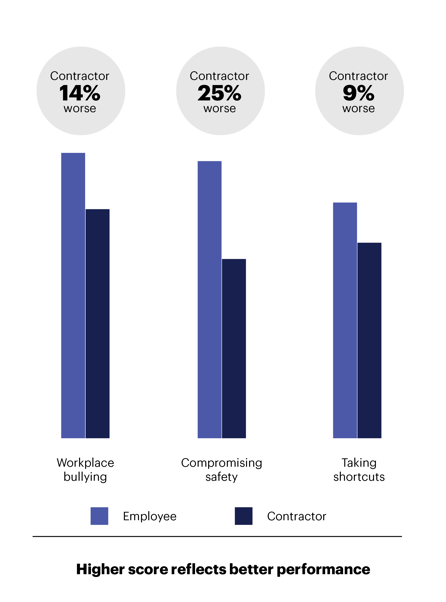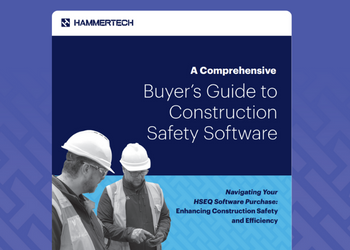Subcontractors feel under significant pressure to compromise safety in order to complete jobs on time, according to research released this month.
Risk management advisers FEFO Consulting found subcontractors were more likely to experience this pressure compared with direct employees (25% worse), and more likely to compromise safety by taking shortcuts (9% worse).
Release of the FEFO research coincides with National Work Safe Month, which focusses this year on work health and safety with the tagline ‘Know Safety, Work Safely’. In construction, subcontractors play a huge role in meeting safety standards and ultimately the safety of workers. Both HammerTech and FEFO share the ethos that it’s vital to better understand this difference and find solutions to equalise safety conditions for all workers – no matter their employer.
FEFO, which advises clients on risk, health and safety across a range of sectors including construction and mining, has been compiling its Health & Safety Index for the past three years. Based on responses to 55 benchmark questions, and drawing on hundreds of thousands of datapoints, the Index provides an independent assessment of the HSE challenges and opportunities facing industry today.
FEFO managing director Mark Wright said: “While overall safety of subcontractors and direct employees is broadly similar, the research highlights a number of safety aspects where subcontractors lag the permanent workforce of an organisation.”
“Generally, they returned poorer scores for praise and recognition, bullying, psychological safety, and feeling under time pressure.”
Mark Wright, General Manager, FEFO Consulting
The Health & Safety Index examines safety performance and perceptions across four main areas: safety systems, safety leadership, safety engagement and worker health and wellbeing, with the last category including a particular focus on mental health.
“Of the four areas, subcontractors recorded their lowest against health and wellbeing measures,” Mr Wright said. “Generally, they returned poorer scores for praise and recognition, bullying, psychological safety, and feeling under time pressure.”

Shift workers
And the picture was even starker for subcontractors performing shift work, who recorded poorer mental health results compared to non-shift workers. Most notably, a mismatch was identified between workers knowing how to get the job done compared with having the actual freedom to perform the work appropriately.
“While shift workers were generally more confident about the best way to complete a job compared with non-shift workers, they were more likely to be exposed to bullying (27% worse) and more likely to feel they didn’t have the freedom to perform the job as they would like to (6% worse),” Mr Wright said. “This clearly had potential flow-on effects to their mental health, with shift workers scoring lower on readiness to talk about mental health (8% worse), impact of work on health and wellbeing (9% worse) and impact of work on sleep (11% worse).”
“While shiftwork is more common for civil construction and events than in the building industry, these findings still highlight the importance considering workers wellbeing, fitness for work and fatigue management in any business.”
Need for efficient solutions that decrease burdens on business rather than increasing them
The Index highlights where organisations might have scope to improve safety, and is often used by companies to benchmark their performance and measure improvements over time. While most organisations recognise the challenges in managing subcontractors, Mr Wright said the key was to engage with the entire workforce to find solutions that could be implemented efficiently rather than adding to red tape and other burdens already weighing on employers.
“Subcontractors play a crucial role in the construction industry,” Mr Wright said. “They are used for a reason – their specialist skillset, the management of risk and the flexibility they can bring to an organisation, for example.”
“However, subcontracting carries with it particular challenges. Subcontractors are often called in at the last minute, or their business model may impose pressure to complete jobs quickly. This can lead to people taking shortcuts or not waiting to be properly briefed.”
The good news
“The good news is that we have the data to identify particularly problematic areas. And the solutions are out there. There is no doubt that a poor record on safety or workforce wellbeing carries financial costs for an organisation, so the motivation to improve is there. Often it is just a matter of companies taking the time to fully examine their performance and invest in improvements.”
Technology opportunities
Increasingly sophisticated software solutions that are purpose-built for construction projects offer significant opportunities to increase worker safety, Mr Wright said. Often these quickly paid for themselves through reduced administration time and improved performance. “There is an appetite not just to improve, but to simplify the process as well. For example, with the availability of construction software there are opportunities to both automate processes and improve project oversight at the same time.”
HammerTech Tip: consider solutions that don’t just digitise documents but support workflows so everyone including subcontractors can be digitally connected to your processes at the right time. This not only improves the quality of EHS information collected but also reduces waiting times for work approval. Plus – when processes are digital subject matter experts from anywhere can remotely help to review and support projects with no delay.
Culture and Leadership
Another clear opportunity to improve safety lay with focussing on the culture and leadership of organisations. “A commitment to safety must come from the top, establishing an environment where both staff and subcontractors prioritise worker welfare and are empowered to raise concerns as they arise – and ideally before a safety incident occurs.”
Mr Wright said leaders should work alongside supervisors to demonstrate genuine care, praise and recognition. They should proactively reach out to talk about mental health, ask open questions, offer free independent resources, and support the workforce to feel comfortable talking about mental health.
On the culture side, it was important to create a safe space to enable contractors to build strong relationships, and speak honestly and openly as a group. “It doesn’t matter if it’s a BBQ, snooker, a dart competition at the local pub or something the contractors themselves come up with. Creating the right environment for honest conversations can make all the difference.”
Learn from the negatives, leverage the positives
Businesses should play close attention to their lag and lead indicators on safety performance. Mr Wright said. And while it was essential to learn from safety incidents, companies should also consider what was going well. “Sometimes the easiest change is to leverage what is going well, which helps to address what is not going so well,” he explained. “Again, technology is enhancing the depth and timeliness of data available to a business.”
HammerTech Tip: Real-time EHS data insights should be made visible to subcontractors automatically to improve engagement and accountability. Ideally this is through live dashboards that remind teams of the most urgent actions. They also highlight areas for improvement or coaching opportunities so contractors can provide targeted support and advice to subcontractors.
Communicate, Communicate, Communicate
Finally, Mr Wright said communication was key to productive, efficient and safe engagement of subcontractors. “Open channels of conversation ensure subcontractors have easy access to the information they need to do a quality and safe job,” Mr Wright said. He suggested companies should coach senior leaders to be visible and to engage with the workforce. “Explore ways senior leaders can specifically ask curious questions about time pressures and learn from contractors. Visibility can also be enabled by using technology and innovative methods to communicate and share information with the workforce.
Setting clear expectations – on deadlines, safety and workplace behaviour - was also essential. “If you set clear expectations early in the contractor lifecycle, this builds greater levels of trust, and also minimises the administrative burden of micromanaging contractors.”
“Improved safety and greater efficiency – now that’s good for everyone.”
For guidance on optimising the safety of your contractors, contact FEFO Consulting here. For more information on how HammerTech’s HSE software can help your construction business, speak with us.




